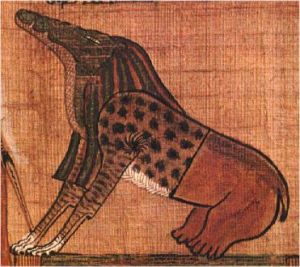m (→Description) |
m (→Main beliefs) |
||
| Line 21: | Line 21: | ||
Ma'at was regarded as the personification of the principles of truth and justice. The hearts of those who failed the test were given to Ammit to devour, and their souls were not permitted to enter Aaru, having to be restless forever - dying a second time. | Ma'at was regarded as the personification of the principles of truth and justice. The hearts of those who failed the test were given to Ammit to devour, and their souls were not permitted to enter Aaru, having to be restless forever - dying a second time. | ||
Ammut was not worshipped, and was never regarded as a goddess. Instead, she embodied all that the Egyptians feared, threatening to bind them to eternal restlessness. The Egyptians believed the body was the key to eternal life (hence mummification); with the body devoured the afterlife would be miserable. | |||
In some traditions, Ammit was said to stand by a lake of fire, into which the unworthy hearts were cast, rather than her eating them. In this role, Ammit was more the lake guardian than the destroyer, which some scholars believe may be evidence of syncretism of a ''fiery lake'' belief, from an as yet unidentified elsewhere. In still another version, Ammut ate the condemned person, rather than only the heart. An evil person then dissolved forever in her stomach. | In some traditions, Ammit was said to stand by a lake of fire, into which the unworthy hearts were cast, rather than her eating them. In this role, Ammit was more the lake guardian than the destroyer, which some scholars believe may be evidence of syncretism of a ''fiery lake'' belief, from an as yet unidentified elsewhere. In still another version, Ammut ate the condemned person, rather than only the heart. An evil person then dissolved forever in her stomach. | ||
Some experts have linked Ammit with the goddess [[Tawaret]], who has a similar physical appearance and, as a companion of [[Bes]], also protected others from evil. Other authors have noted that Ammit's lion characteristics, and the lake of fire, may be pointers to a connection with the goddess [[Sekhmet]]. | Some experts have linked Ammit with the goddess [[Tawaret]], who has a similar physical appearance and, as a companion of [[Bes]], also protected others from evil. Other authors have noted that Ammit's lion characteristics, and the lake of fire, may be pointers to a connection with the goddess [[Sekhmet]]. | ||
==Source== | ==Source== | ||
Latest revision as of 21:28, 2 October 2010
In Egyptian mythology, Ammut (also spelt Ammit, Ammet, Amam, Amemet and Ahemait) is a formidable deity that stands in the Hall of Ma'at to devour the souls of the unrighteous.
Etymology
Her role is reflected in her name, which means Devourer or, more accurately, and less euphemistically, Bone Eater, and her titles such as Devourer of the dead, Devourer of millions (Am-heh in Egyptian), Eater of hearts, and Greatness of Death.
Description
Ammut is depicted with the head of a crocodile or dog, the front part of her body like a lion or leopard, and her back part in the form of a hippopotamus. These animal were considered as the most dangerous to the ancient Egyptians.
Place
Ammit was said to live near the scales of justice, in the underworld, Duat, where the hearts of the dead were weighed by Anubis against the feather in Ma'at's headress.
Main beliefs
Ma'at was regarded as the personification of the principles of truth and justice. The hearts of those who failed the test were given to Ammit to devour, and their souls were not permitted to enter Aaru, having to be restless forever - dying a second time.
Ammut was not worshipped, and was never regarded as a goddess. Instead, she embodied all that the Egyptians feared, threatening to bind them to eternal restlessness. The Egyptians believed the body was the key to eternal life (hence mummification); with the body devoured the afterlife would be miserable.
In some traditions, Ammit was said to stand by a lake of fire, into which the unworthy hearts were cast, rather than her eating them. In this role, Ammit was more the lake guardian than the destroyer, which some scholars believe may be evidence of syncretism of a fiery lake belief, from an as yet unidentified elsewhere. In still another version, Ammut ate the condemned person, rather than only the heart. An evil person then dissolved forever in her stomach.
Some experts have linked Ammit with the goddess Tawaret, who has a similar physical appearance and, as a companion of Bes, also protected others from evil. Other authors have noted that Ammit's lion characteristics, and the lake of fire, may be pointers to a connection with the goddess Sekhmet.

